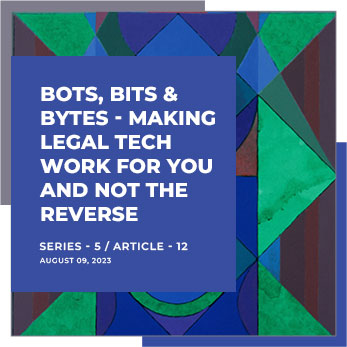‘In The Beginning, There Were Boxes’…dozens or even scores of cardboard boxes filled with thousands or tens of thousands of paper documents delivered to lawyers’ offices for physical
‘discovery’ or brought by law clerks navigating warehouse two-wheelers into courtrooms.
By the 1980s, as documentation shifted from paper and ink to bits and bytes and the delivery method switched from postal to electronic, the challenge became ‘how to quickly unearth the smoking guns buried among otherwise irrelevant content’ within millions of documents. In 2021, the challenge remained the same, only now it is addressed by finely-tuned algorithms.
Scope of the Problem—In Zettabytes
In the course of a seven-year-long patent infringement suit between Samsung and Apple, Samsung produced 3.6 terabytes of data, comprising approximately 11 million documents. The cost of collecting, processing, and producing such vast amounts of data over 20 months was over $13 million. Although that eDiscovery process may have broken a record, both in terms of volume as well as cost, a more typical civil dispute can involve an average of 130 gigabytes collected from a dozen custodians. In
2012, the cost of processing each gigabyte of eDiscovery was $18,000, resulting in an average case cost of
$2.3 million. Today, that cost has dropped by half to about $9,000 per gigabyte.
The number of documents subject to eDiscovery continues to grow exponentially as new sources of electronic information become discoverable—including smartphones, which now account for 40% of all global eCommerce transactions, and a plethora of social media accounts. Almost 90% of the world’s existing data has been created within the last few years, and by the end of 2020, it was estimated that global data would reach 44 zettabytes. It is further estimated that by 2025, the amount of global data generated daily will be 463 exabytes.
What does it entail for eDiscovery?
Paralleling this growth in electronic data is the corresponding growth in the global eDiscovery industry, which is expected to grow from a $9.3 billion market in 2020 to $12.9 billion by 2025—a CAGR of 6.6%. Driving this growth are factors such as governance of data analytics, a restructuring of regulatory policies, and an overall increase in global litigation, especially among high-tech and bio-tech giants sparring in both domestic and cross-border forums. To meet this demand, eDiscovery vendors must constantly upgrade their tools and technology while simultaneously remaining cost-effective in a highly competitive arena. The logical means of efficiently capturing, managing, storing, and delivering Electronically Stored Information (ESI) is through advances in AI-based analytics for eDiscovery.
Predictive Coding and Machine Learning
Artificial Intelligence (AI)-based analytics improve both the speed and quality of the eDiscovery process by interpreting meaningful patterns in collected data. Predictive coding is a Machine Learning (ML) process that employs algorithms to ‘train’ software by seeding datasets into a comprehensive database, which identifies and determines documents that are relevant to pending litigation. However, the self-learning logic of eDiscovery must still be based on a review of test documents ‘taught’ by trained lawyers. The ML process then applies the same algorithm to a larger document group. This streamlines the document review process and makes it more cost-effective.
Document Review and COVID-19
If the software is already trained to select what is relevant to the subject litigation versus what is irrelevant, the obvious question is – ‘Why do we need hundreds of Document Review teams staffed by thousands of attorneys reviewing eDiscovery across borders and time zones?’ Simply put, AI has not yet reached that point where the machine can sufficiently ‘think’ to decide what document is ‘responsive’ to the demand for discovery. For that, it still takes the other AI, which is ‘Attorney Intelligence’.
Document Review teams generally assembled in designated rooms at Document Review centers operated by the Top 10 eDiscovery solutions providers until a year and a half ago—i.e., ‘pre-COVID-19’ times. But with the pandemic have come logistical changes necessitated by social distancing rules and travel bans. Although it is anticipated that the impact of COVID-19 is short-term, it will have significant ramifications for businesses and eDiscovery vendors, requiring new practices such as the work-from-home model, expanded Virtual Private Network (VPN) connectivity, and the adoption of cloud-based eDiscovery solutions. These changes have forced eDiscovery vendors to re-think where Electronically Stored Information is stored and how it can be accessed securely.
Increased Risk of Cyberattacks and Data Theft
Although cybersecurity and data security have always been a top priority of eDiscovery vendors, that concern has been heightened in the wake of the transition to remote-staff operations. Between 2016 and 2017, the number of cyberattacks and data breaches in general increased by 600%. However, most enterprises continue to pay too little attention to sound cybersecurity practices, and not guaranteeing the cybersecurity of data transmitted to and from home offices puts sensitive, privileged information at an even greater risk. As eDiscovery solution vendors, in particular, process crucial business data on behalf of business enterprises, data compromise under their watch may spell the end of that vendor’s continued participation in the industry. The risk of cyberattack and data theft is one factor cited as a current restraint on the growth of the global eDiscovery market.
Cloud-based or On-site
Cybersecurity concerns and the need to monitor the bottom line closely during a pandemic downturn have led some businesses to opt for on-site ESI. However, the costs associated with such a move may rival the expenses associated with outsourcing to professional eDiscovery solutions. It is true that licensing, uploading fees, coding, and other such costs may make the eDiscovery vendor option unattractive. However, enterprises must factor in the costs of new IT infrastructure, updating and maintenance of the systems, and increased self-service cybersecurity methods before concluding that they will realize a saving via an in-house solution. In this present environment, the on-premises option is expected to gain an increasing share of the eDiscovery market. This is due to the perceived benefits of flexibility, scalability, and lower infrastructure costs.
Contemporary Staffing Solutions in eDiscovery-driven Trials
It appears that eDiscovery requires two major contributions from a law firm or service provider—legal and technical expertise. Managing terabytes and zettabytes of data require human talent with both hands-on experience in the technology and a strong handle on the legal aspects and responsibilities of the case, which can include knowledge of its subject matter chain-of-custody rules, rules of evidence, etc. Depending on the size of the trial available, the organizational effort requires the firm to orchestrate clients, technical experts, project managers (and their teams), document review attorneys, in-house counsels, service providers, and in-house technical experts across different time zones and entities.
One standard solution seen in the industry is to hire skilled project managers, either in-house or through contracting a service provider. The
‘holy grail’ of eDiscovery project managers for most firms is an individual with a bar license (or law degree) with proven abilities in Electronic Document and Records Management Systems (EDRMS) along with platforms that support the hosting and processing of electronic records. However, as one would expect, such talent can be expensive. Therefore, an alternative path is to hire two separate project managers who work in tandem to manage the two buckets during eDiscovery – legal and technical. During the process, large volume firms also provide complex project management ecosystems layered with project coordinators, project assistants, data processing and hosting teams, information security experts, and dedicated client managers.
Large, voluminous disputes are of incredible value to litigation groups as they can serve as a reliable source of client billables to help the law firm grow for years to come. This has made litigation and eDiscovery a very competitive space in the market, with clients assessing how a firm manages bigger cases from an organizational perspective. If a firm hosts and processes their data and does all document review in-house as opposed to through a vendor, it can be
attractive for the client as the litigation group acts as a ‘one-stop shop’ for their needs. However, this requires an incredible investment and change management within the law firm – which is precisely why eDiscovery service providers remain a competitive option for firms still in their growth stages.
Getting around the high cost associated with the collection, amalgamation, processing, review, and preservation of documents when demanded for litigation eDiscovery is impossible, regardless of whether a company decides on cloud-based solutions or on-site storage . Due to the nature of huge eDiscovery-driven trials, it is easy for things to get ‘lost’ in a sea of documents and reports flowing within an organization. A firm must carefully allocate responsibilities to skilled ‘point-individuals in the litigation and eDiscovery process to manage quantity with quality legal and technical service.
“PARALEGALS ARE OFTEN HIRED FOR INTENSIVE SUPPORT ROLES WITHIN AN ATTORNEY’S CASELOAD….
…A WIDE RANGE OF TRULY SUBSTANTIVE LEGAL WORK CAN NOW BE LAWFULLY ASSIGNED TO A PARALEGAL“
LAWYER SHOULD FAMILIARIZE HIMSELF OR HERSELF WITH THE APPLICABLE ETHICAL FACTORS…“
Executive Summary
The Issue
Discovery has introduced streamlined efficiency and scalability into the tiresome process of document review. But with that comes new challenges relating to security, automation, and data protection.
The Gravamen
Unquestionably, lawyers are responsible for their client’s documents and must maintain privilege and general duty confidentiality in their client’s affairs. These duties extend to managing documents carefully in an ever-changing data-driven eDiscovery process. Ethical concerns also require that the lawyers do not completely remove themselves from the review process.
The Path Forward
State-of-the-art technology and layered human review processes are the most certain ways of controlling any exposure to liability.
Action Items
1. Point-persons on a project:
Complex document-heavy litigations quickly become an organizational effort spanning different stakeholders. The first step in this long process is to appoint a project manager who will be responsible for the overall progress of an eDiscovery matter.
2. Weaponize the technology:
The idea is to work smarter, not harder. If cost-effective solutions exist to support your firm’s eDiscovery needs, it is wise to invest in them as they ease many administrative burdens and redundancies that are prevalent in document review.
3. Gather the Troops:
Automation in eDiscovery is yet to reach a point where human intervention is not required. In order to avoid any risk of malpractice, law firms must ensure that document review teams are formed across different levels of seniority.
4. Organize the review process and oversee deliverables:
The project manager must carefully organize the document review efforts and maintain a tight delivery schedule to ensure that court deadlines are on track. Easier said than done, but in today’s algorithmic and data-driven world, the process is much simpler.
Further Readings
https://www.marketsandmarkets.com/Market-Reports/e-discovery-market-11881863.html
https://www.everlaw.com/blog/2022/01/14/what-is-predictive-coding/
https://zapproved.com/blog/on-premise-versus-on-demand-ediscovery-software/
https://edrm.net/resources/frameworks-and-standards/edrm-model/
https://www.mimecast.com/blog/covid-19-and-the-dire-need-for-e-discovery/







